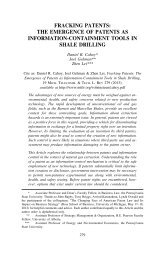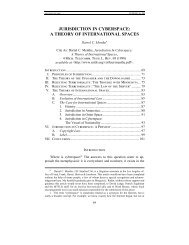the chinese regulatory licensing regime for pharmaceutical products
the chinese regulatory licensing regime for pharmaceutical products
the chinese regulatory licensing regime for pharmaceutical products
You also want an ePaper? Increase the reach of your titles
YUMPU automatically turns print PDFs into web optimized ePapers that Google loves.
450 Michigan Telecommunications and Technology Law Review [Vol. 15:417<br />
may have to increase its budget or staff in order to meet deadlines. The<br />
time limits, if designed inappropriately, may even increase <strong>the</strong> error costs<br />
of <strong>licensing</strong> decisions because officials may not have sufficient time to<br />
fully consider <strong>the</strong>ir decisions. In terms of efficiency, <strong>the</strong> statutory time<br />
limits can only be justified if <strong>the</strong> reduction in delay costs resulting from<br />
<strong>the</strong>ir use exceeds <strong>the</strong> possible increase in error costs and o<strong>the</strong>r administrative<br />
costs. Accordingly, <strong>the</strong>re is reason to doubt whe<strong>the</strong>r <strong>the</strong> statutory<br />
time limits on Chinese drug <strong>licensing</strong> procedures are set at an efficient<br />
level.<br />
7. The Reassessment Procedure Versus <strong>the</strong> Recognition Procedure<br />
As previously mentioned, <strong>the</strong> <strong>licensing</strong> procedure <strong>for</strong> an RCID in<br />
China is a reassessment procedure. If <strong>the</strong> exclusive aim of this <strong>licensing</strong><br />
requirement is to prevent unsafe and inferior drugs from entering <strong>the</strong><br />
country and to make good drugs available to domestic consumers, can<br />
we simply rely on recognition procedure ra<strong>the</strong>r than reassessment procedure<br />
in China<br />
Economically speaking, <strong>the</strong> purpose of procedures is to minimize<br />
<strong>the</strong> sum of <strong>the</strong> error costs and administrative costs. 184 Let letters A and E<br />
respectively represent <strong>the</strong> administrative costs and error costs <strong>for</strong> a procedural<br />
arrangement. Accordingly, A 1<br />
and E 1<br />
represent <strong>the</strong> administrative<br />
costs and error costs of reassessment procedure; A 2<br />
and E 2<br />
denote <strong>the</strong><br />
administrative costs and error costs of <strong>the</strong> recognition procedure. Fur<strong>the</strong>rmore,<br />
assume that letter T 1<br />
represents <strong>the</strong> aggregation of A 1<br />
and E 1<br />
,<br />
and letter T 2<br />
denotes <strong>the</strong> sum of A 2<br />
and E 2<br />
. If T 1<br />
> T 2<br />
(i.e., A 1<br />
+ E 1<br />
> A 2<br />
+<br />
E 2<br />
), <strong>the</strong>n recognition procedure is more efficient. If T 1<br />
< T 2<br />
(i.e., A 1<br />
+ E 1<br />
<<br />
A 2<br />
+ E 2<br />
), <strong>the</strong>n reassessment procedure is superior. Since <strong>the</strong> reassessment<br />
procedure usually takes more time and requires more steps than <strong>the</strong> recognition<br />
procedure, it involves more delay and o<strong>the</strong>r administrative costs<br />
(i.e., A 1<br />
> A 2<br />
). Under such circumstances, if E 1<br />
≥ E 2<br />
, <strong>the</strong>n T 1<br />
> T 2,<br />
<strong>the</strong> recognition<br />
procedure is superior. Even when E 1<br />
< E 2<br />
, if A 1<br />
- A 2<br />
> E 2<br />
- E 1<br />
,<br />
<strong>the</strong>n T 1<br />
> T 2<br />
and <strong>the</strong> recognition procedure is still <strong>the</strong> more efficient<br />
choice.<br />
Whe<strong>the</strong>r E 1<br />
≥ E 2<br />
mainly depends on <strong>the</strong> relative competence of <strong>regulatory</strong><br />
agencies in <strong>the</strong> importing and exporting countries. If <strong>the</strong><br />
<strong>regulatory</strong> agency in <strong>the</strong> exporting country can give a more accurate<br />
evaluation of <strong>the</strong> safety and efficacy of a drug than <strong>the</strong> agency in <strong>the</strong> importing<br />
country, <strong>the</strong>n E 1<br />
> E 2<br />
and T 1<br />
> T 2<br />
. In that case, it makes economic<br />
sense <strong>for</strong> <strong>the</strong> <strong>regulatory</strong> agency in <strong>the</strong> importing country to choose <strong>the</strong><br />
recognition procedure. Generally speaking, developing countries have<br />
184. Posner, supra note 147, at 599.






